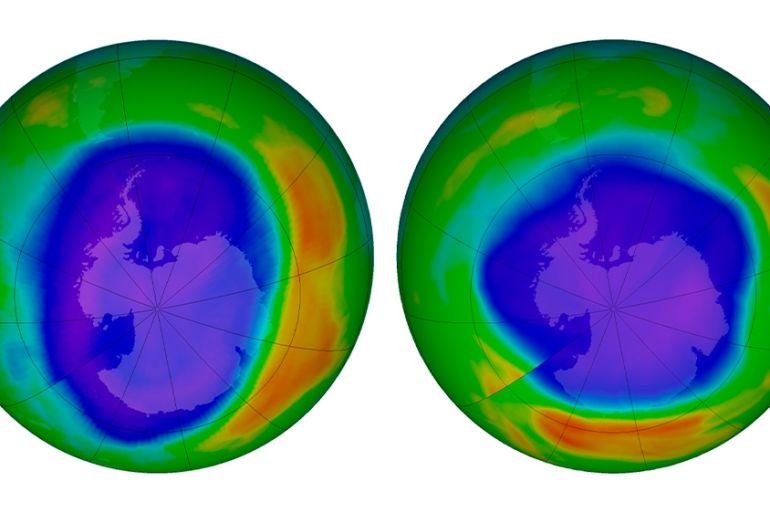China blamed for surge in ozone-depleting emissions
Researchers study atmospheric data to show rise in emissions of banned ozone-depleting CFC-11 from northeastern China.

China is to blame for much of the increase in banned ozone-depleting substances (ODS) since 2013, according to a study published in the journal Nature, with factories in the country’s northeast accused of violating a global production ban.
Trichlorofluoromethane, also known as CFC-11, was once common in refrigerators and air conditioners, but is now banned under the Montreal Protocol, a treaty designed to protect the Earth’s ozone layer by phasing out the production of CFCs throughout the world.
Keep reading
list of 4 itemsPhotos: Heavy rains, lightning in Pakistan kill at least 50 people
Inside the pressures facing Quebec’s billion-dollar maple syrup industry
Coral reefs around the world experiencing mass bleaching, scientists say
The ban led to a sharp decline in the concentration of CFC-11 in the atmosphere until 2012, but when the decline slowed, scientists began to suspect new emissions because CFC is not produced in nature.
Researchers collecting air samples in Hawaii reported in May last year that new emissions appeared to be coming from East Asia.
The latest investigation, published on May 22 by researchers from Australia’s Commonwealth Scientific and Industrial Research Organisation and Britain’s University of Bristol, was able to pinpoint the source of the emissions to northeast China by analysing atmospheric data gathered from South Korea and Japan.
They found more than half the global rise in prohibited CFC-11 – about 7,000 tonnes a year since 2013 – could be traced to the industrial provinces of Shandong and Hebei.
Lead author Matthew Rigby, an atmospheric chemist at the University of Bristol, told the Nature the findings were “pretty unequivocal”.
As part of the study, four independent modelling groups analysed the circulation patterns to work out where the CFC-11 emissions that were blowing into Japan and South Korea were coming from.
“CFCs are the main culprit in [the] depletion of the stratospheric ozone layer, which protects us from the Sun’s ultraviolet radiation,” Rigby told Reuters news agency.
The scientists said they had still to find the source of a further 4,000 tonnes of new emissions annually.
‘Rogue users’
China said last year it had already eliminated as much as 280,000 tonnes of annual ODS production capacity and was speeding up efforts to phase out other ozone-damaging chemicals. It signed the Montreal Protocol in 1991.
|
|
A report last year by the London-based Environmental Investigation Agency (EIA) said dozens of Chinese companies were still using CFC-11 to make polyurethane foam.
“Because it’s very effective at what it does, there have been rogue users of old supplies and rogue producers who flout international agreements that their governments have signed up to,” Ian Rae, an academic at the University of Melbourne’s School of Chemistry and a technical adviser to the Montreal Protocol, told Reuters.
China launched a special inspection campaign into 3,000 foam manufacturers across the country last year and promised to punish any breaches of the ban on ozone-depleting chemicals.
It said in March that it had shut down two manufacturing spots that produced CFC-11.
The Ministry of Ecology and Environment said late on Thursday it had paid close attention to the unexpected rise in global CFC-11 levels reported last year.
It said its investigation into polyurethane foam makers had so far revealed no large-scale illegal use, but said enterprises involved in illegal activities had got better at covering up their operations.
The ministry noted there was a lot of uncertainty in recently published papers about the “amount, location and source of the emissions”, and called for better detection and supervision capabilities.
Two decades ago, CFCs, which are more potent greenhouse gases than carbon dioxide or methane, accounted for around 10 percent of human-induced global warming.
Rising emissions could prevent ozone from returning to normal levels, scientists warn.
“If emissions do not decline, it will delay the recovery of the Antarctic ozone hole, possibly for decades,” said Paul Fraser, an honorary fellow at the CSIRO Climate Science Centre in Australia.
CFC-11 persists in the atmosphere for about half a century and still contributes about a quarter of all chlorine – the gas that triggers the breakdown of ozone – reaching the stratosphere.